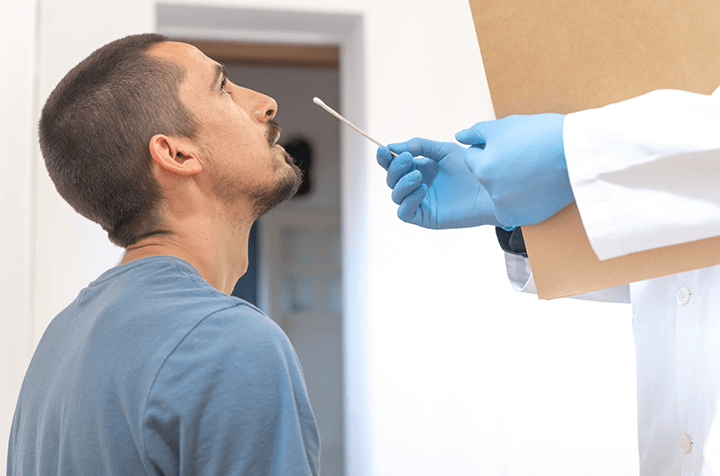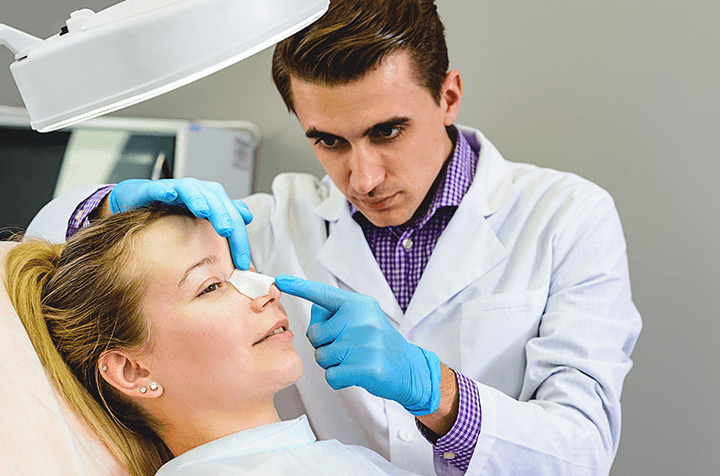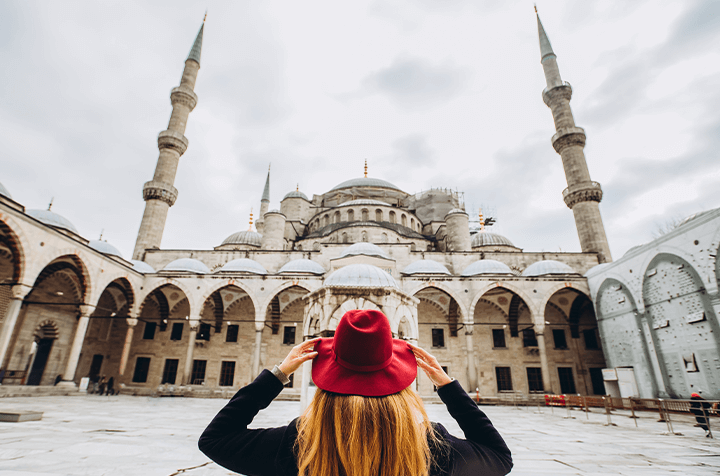We are all exposed to aging and gravity. The appearance of our eyes naturally changes over time. However, there is an excellent treatment that can rewind the time for your eyes: Eyelid surgery.
Book your consultation
Eyelid surgery (also known as Blepharoplasty) can be performed on lower eyelids, upper eyelids, or both. Through blepharoplasty, you can get rid of droopy or baggy appearance on the upper eyelids, the excess skin on the upper eyelids that can block the peripheral vision, excess skin on the lower eyelids, and the under-eye bags. While lower eyelid surgery is purely cosmetic, upper eyelid surgery can also improve the peripheral vision.
Learn MoreCosmetic eyelid surgeries are able to solve multiple problems related to eyelids. There are different parts of the surgery that are treating different problems. There are also different approaches for different needs.

With aging, some tissues including the muscles inside your lower eyelid weakens. As a result, the fat inside...

This is a common problem. With aging, the skin of upper eyelids can stretch. This excess skin sags and...

Changes related to the eyes are strong indicators of aging. Droopy upper eyelids are a very common...

Fat inside the upper and lower eyelids may make them look puffy. This is a common complaint. Fortunately...

Upper and lower eyelid surgeries can treat the problem of excess skin, successfully. However, you need...

There are 2 kinds of cosmetic eyelid surgeries: upper eyelid surgery and lower eyelid surgery. If you need...

This is more common for younger patients and provides the possibility of another approach. If you have a...
Experience speaks for itself! Hear out what our patients have said:
At Clineca, we take everything seriously. We understand how important the results are for you. We care about your health and comfort as much as you do. From beginning to end, we inform you, guide you, serve you, and help you.

Surgeries are performed in prestigious fully equipped hospitals in which doctors from all specialties are present.

You will have an online consultation with your surgeon via video chat. After an online examination, and will help you to choose what's the best.

We cooperate with the surgeons who perform a limited number of surgeries each week to ensure the best results.

You can contact our agents 7 days and 24 hours for your questions and concerns, or only support. We'll be fully available for your service.

We provide you with special discounts in luxurious hotels in the vicinity of the hospital. Your comfort is very important to us.

We provide airport transfer and transportation between your hotel and the hospital before/after the surgery via VIP vehicles.

As Clineca, we provide you with patient accompaniment, who will visit you every day in your hotel room during the resting period.

The price includes fees of the surgeon, operating room, hospitalization, tests, medications and medical visits by a nurse.

The price includes hotel layover (including breakfast), and transportation between the airport, the hotel and the hospital.

Interpreter service, BBL pillow, neck pillow (rhinoplasty), eye mask, voltage converter and many others that will enhance your satisfaction.

Turkey is a leading player in medical tourism, and Istanbul, which is an extremely beautiful touristic city, is the plastic surgery capital of Turkey.
Clineca has a holistic approach. We believe that everything should be right for a satisfactory cosmetic surgery experience, including your days in Istanbul. We plan every detail of your journey.
After you fill the form, one of our agents will contact you. They will inform you about the whole experience, in detail. If requested, they will arrange an online consultation for you.
You'll have an online consultation with your surgeon via video chat. They will perform an online examination and help you to choose what the best approach to your case is.
We'll plan your whole journey including your surgery date and accommodation. We'll inform you about every need; from preparing your suitcase to advice before the procedure.
Our VIP transportation vehicle will be ready at the airport for you. We’ll drive you to the hospital and they'll get a blood and the C19 test. Then, we'll take you to your hotel.
We’ll take you from your hotel to the hospital. After your examination, the same day you’ll have the surgery. You will stay at the hospital 1-2 day(s), depending on the procedure.
After your stay at the hospital, we'll drive you to your hotel. A wellbeing assistant will visit you every day to inform you, to examine, and to provide medical care during the week.
We'll gladly and proudly show you around our beautiful city. We’ll be very happy to provide you with professional guidance in historical sightseeing, shopping and entertainment.
We’ll take you to 1-week follow-up. After your examination and removal of bandages if required, we’ll inform you about the recovery period. Then, we'll drive you to the airport.
During your recovery, we'll inform you, check on you, and answer your questions 24 hours and 7 days. We'll expect you to send photos periodically to follow your recovery period.

It is not hard to be eligible for an eyelid surgery. If you are reading this, you are probably a candidate!
The first requirement to be eligible for an eyelid surgery is to be healthy. If you are healthy and have realistic expectations, then you are a good candidate for this procedure!
Children are able to have otoplasty when the ears are almost fully grown, and the ear cartilage complete its development and is stable enough for correction.
Learn MoreThe outcomes of blepharoplasty can be analyzed in three main categories: aesthetical, health-related, and psychological.
Your eyelids determine how your eyes look like, and the way your eyes look like determines how you are perceived by the others. The appearance of your eyelids has a tremendous effect on your facial aesthetics. Upper and lower eyelid surgeries can significantly rewind the effects of aging and gravity. With an upper eyelid surgery, you can get rid of baggy or droopy appearance on your upper eyelids and the excess skin of them which interferes with your peripheral vision. With a lower eyelid surgery, you can get rid of the excess skin of your lower eyelids and the bags under them.
Lower eyelid surgery is done just for cosmetic reasons. However, upper eyelid surgery has an important health benefit, in addition to its cosmetic benefits. It is very common that with aging, sagging on the upper eyelids develop. This excess skin can block your peripheral vision. In addition to the psychological distress caused by this, which is also dangerous, especially when you are in the traffic. An upper eyelid surgery can easily remove the excess skin and give you your uninterrupted peripheral vision back.
The psychological outcomes of the procedure are as important as the physical ones. The eyes are the focus of attention. They are the most prominent feature on our faces. If you don’t like the way your eyes look, you won’t want others to look you in the eye. If you think the appearance of your eyes make you look older, you may not want to look in the mirror. Fortunately, eyelid surgeries achieve amazing result when done by an experienced and talented plastic surgeon. Elimination of problems related to the appearance of your eyes can lead to significant psychological and social improvements.

Eyelid surgery is a cosmetic surgery procedure performed to change the appearance of upper, lower, or both eyelids.

Like all kinds of surgery, blepharoplasty requires anesthesia. Usually, in the eyelid surgery, local anesthesia combined with sedation is used. Local anesthesia will be applied on your eyelids. You will be awake but sedated during the procedure.
There are 2 different cosmetic eyelid surgeries: the upper eyelid surgery and the lower eyelid surgery. You can have one, or both. If you are having both, your surgeon will first work on the upper eyelids. All the incisions will be made carefully so that they will be concealed within the natural folds and creases of your eyelids. The surgery takes around 2 hours if both upper and lower eyelids are done. There is also a functional eyelid surgery: ptosis, which is a condition where the upper eyelid droops, repair. *1 It can be done in combination with your cosmetic eyelid surgeries.


Your surgeon will make an incision on the natural crease of your upper eyelid. They will remove excess skin and muscles and remove or relocate fats inside your upper eyelid. *2 Then they will repeat the same procedure for your other upper eyelid.
Your surgeon will make an incision below the lash line of your lower eyelid (or inside your lower eyelid). They will remove excess skin and muscle and remove or relocate fat inside your lower eyelid (if the incision is made inside the eyelid, no skin is removed). Then they will repeat the same procedure for your other upper eyelid.

Eyelid surgery, or blepharoplasty, is a widely performed operation, thus the risks are minimized. But as with any other surgery, especially if done by inexperienced surgeons, there can be some complications such as:
After the surgery, there will be stitches on your eyelids for up to a week.
Right after the surgery, ointment will be applied on your eyes to prevent them from drying.
Your eyes may also be covered with gauze. You may temporarily experience blurred vision,
light sensitivity, dry or watering eyes, swelling, and bruising. You may also experience some pain or discomfort.
The pain can be easily controlled by painkillers that your surgeon will prescribe to you.
It is important to avoid strenuous activities and exercises for 2-4 weeks.
Because they can increase blood flow to your eyes. You should also be careful
about daily activities that can increase the pressure in your head, such as lifting
heavy objects, bending, or lying on your back without keeping your head elevated.
The swelling and bruising are gone within one to two weeks. *3 Then, you will feel ready to go outside and have fun! The recovery time for eyelid surgeries is very short! However, the scars can take several months to fade. You should not expose your eyelid skin to too much sunlight until the healing process is fully complete.
A wellbeing assistant will visit you in your hotel room every day during the first week after the surgery. We will expect you to be in our clinic for your post-op examination 1 week after the surgery, before you leave Istanbul. We will still follow your recovery process while you are away. Clineca will provide you with complete support and inform you about everything you need to know during your recovery. We will be with you from your consultation to the very end of your recovery.

“A natural and youthful appearance is what we seek through eyelid surgeries. We are not looking for artificial looks. We unleash your natural beauty and energy by removing the effects of time.”

During your online consultation, your surgeon will ask you questions about your medical history. They will also conduct a physical examination. Your surgeon will inform you about everything you need to know before the surgery. Clineca will provide you with complete guidance and support before your surgery. You will have a complete and detailed list of instructions.
Most important instructions include,


What you need to do after the surgery will be explained to you in detail by your surgeon and Clineca will provide you with all the support and guidance you need. Most important instructions include:

“An upper eyelid surgery is not only a cosmetic procedure. We can remove the excess skin of the upper eyelids that can block the peripheral vision. So you not only look better, you will also see better!”

We know you have many questions. Having realistic expectations and deciding to have a cosmetic surgery requires information. Here you can find answers to frequently asked questions about eyelid surgery.
Cosmetic eyelid surgeries are able to address a variety of problems in the eye area. There are different approaches for addressing different problems and needs. You can find solutions to some of these problems below:
1. Bhattacharjee, K., Misra, D. K., & Deori, N. (2017). Updates on upper eyelid blepharoplasty. Indian journal of ophthalmology, 65(7), 551–558. https://doi.org/10.4103/ijo.IJO_540_17
2. Bhattacharjee, K., Misra, D. K., & Deori, N. (2017). Updates on upper eyelid blepharoplasty. Indian journal of ophthalmology, 65(7), 551–558. https://doi.org/10.4103/ijo.IJO_540_17
3. Olds, C., & Most, S. P. (2019). Upper Blepharoplasty. JAMA, 321(13), 1320. https://doi.org/doi:10.1001/jama.2019.1957
4. Oestreicher, J., & Mehta, S. (2012). Complications of blepharoplasty: prevention and management. Plastic surgery international, 2012, 252368. https://doi.org/10.1155/2012/252368